How to choose a battery: 4 models for high-quality heating
The main element of the residential heating system is the boiler. However, radiators that transfer heat to the air circulating in pipes of the air to the room air have almost a greater impact on the heating efficiency. That is why the question of how to choose a heating battery is very important.
Especially for apartment owners who cannot independently control either the temperature or the chemical composition of the coolant.

Radiator Types
Before you decide which radiator to choose for an apartment or house, you must carefully study the most important characteristics of each of the radiator models on the market. Indeed, in spite of the fact that the price of some of them is higher, during the operation this difference can more than pay off with increased service life or resistance to aggressive environmental influences.
Model 1. Cast Iron
The choice of a radiator can be started by considering one of the most familiar to all residents of our country variety - a cast iron radiator. He has been known for more than a dozen years and, despite the fact that a lot of more economical and aesthetic models have appeared on the market, he continues to be popular with many experts in the design of climate systems.
This is due to two indisputable advantages:
- increased strength;
- long service life.
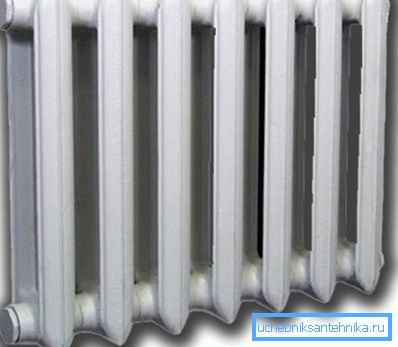
The period of trouble-free operation of the cast-iron battery is about 50 years. However, it is perfect for installation in an apartment connected to a centralized heating system, the coolant in which is often highly contaminated and has an aggressive chemical composition.
Also, the choice of radiators from cast iron is justified if the specialists serving the heating network allow sudden surges in fluid pressure in it. This often leads to depressurization and rupture of radiators made from less durable and reliable material.
The weak sides of cast iron heating panels include:
- low thermal conductivity - this indicator indicates how efficiently the heat energy of hot water in the heating system is transferred to the air in the room (the higher the better);
- high inertia - the cast iron heats up more slowly, but retains heat longer, due to which the disadvantage described above is compensated.
Tip! Small heat transfer of cast iron can also be compensated by a larger area of radiators - you just need to add 2-3 sections in excess of the calculated amount.
Cast iron is an excellent choice for those who do not know how to choose a heating battery in order to install it in the gravitational heating system of a private house or cottage.
Due to the inertia, it continues to heat the room after periodically turning off the boiler with automatic climate control systems. This allows you to significantly save on gas costs or the purchase of liquid fuel. Moreover, cast iron is also suitable for the installation of heating systems with a low coolant temperature.
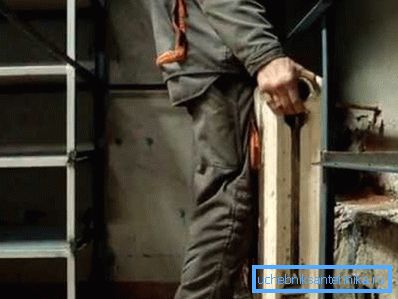
One of the main disadvantages of a cast iron radiator is a lot of weight. The mass of one section exceeds 7 kg, which significantly increases the load on the fixing accessories and structural elements of the building.
Also because of this, it is difficult to design the entire heating system with your own hands. You will not be able to secure the battery having 10 or more sections, you will need to use the help of a partner.
As for the unattractive appearance characteristic of cast-iron heating panels, which were installed in houses built in 70-80s of the last century, now it is not necessary to talk about it.
Modern industry produces a huge number of varieties of cast iron batteries, whose appearance allows them to organically fit into the interior of the room and the modern young man who adores the modernist style, and the respectable gentleman, who prefers the classics.
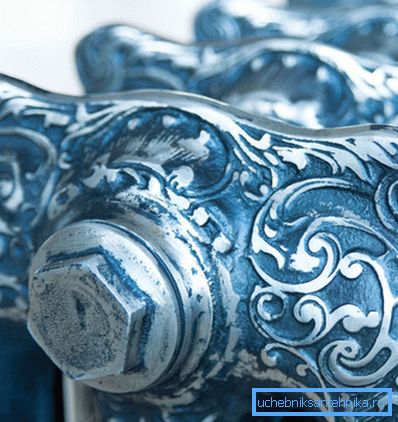
Model 2. Aluminum
Speaking about which battery to choose, it is worth mentioning the aluminum radiator.
It is characterized by the following features:
- excellent appearance, complementing the interior of any room style;
- excellent power indicators, allowing the use of a minimum of sections for heating rooms.
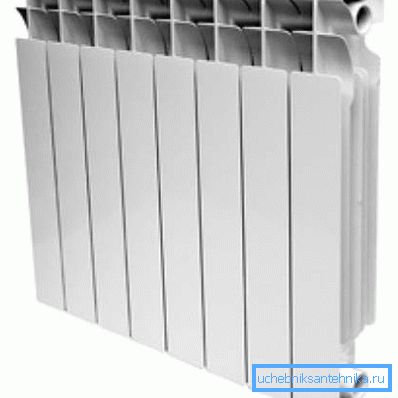
However, the installation manual categorically does not recommend installing such batteries in the central heating systems of apartments. The fact is that the design features of this equipment require direct contact of the non-ferrous metal with the coolant. As a result, increased demands are made on the quality of the latter (especially on the chemical composition of water).
If the liquid is characterized by high acidity, there is a rapid process of corrosion of aluminum, which can cause a complete blockage of the internal channels of the heating radiator.
And, on the contrary, for a private cottage or dwelling, equipped with an individual heating system, aluminum fits perfectly. It is only important to know how to choose the heating batteries for power and other important parameters.
In this case, other features of aluminum panels show up better:
- low inertia, so you can quickly heat the room and finely adjust the temperature of the air in it;
- low weight, which has a beneficial effect on the structural elements of the building and allows the use of less massive mounting hardware;
- high strength, which allows the radiator to withstand an internal pressure in the system that exceeds 16 atmospheres.
As for the appearance, there is also a huge scope for imagination. In addition, these radiators are sold section by section and you can design a battery of the same power that is needed in a particular room.
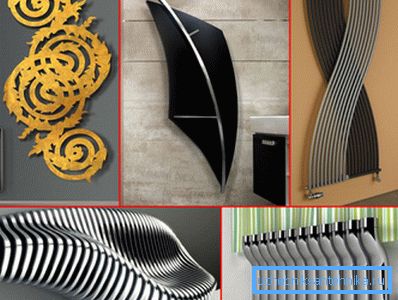
Tip! If you decide to use aluminum batteries for arranging the climate system, refuse to use copper and brass taps, fittings and adapters for pipes. Contact of these metals with aluminum can also be the cause of rapid corrosion.
Model 3. Bimetallic
Modern industry produces a slightly different model of aluminum radiator.
This battery is called bimetallic, as it consists of two main parts:
- steel tubular core through which coolant circulates;
- aluminum heat exchanger, which maximizes heat transfer and as a result, the power (efficiency) of the battery.
The described device has all the advantages of an aluminum panel, but is devoid of its disadvantages.
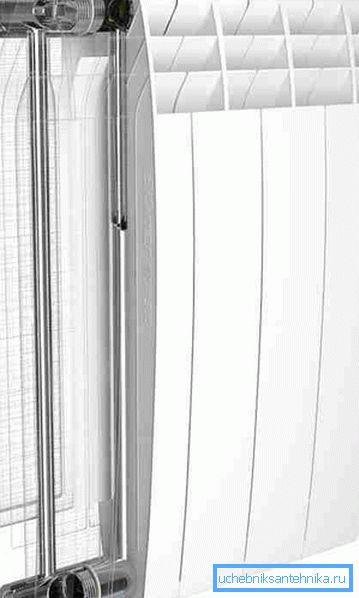
Note! There are cheaper models of bimetallic products, where steel is used only for arranging vertical channels. Their manufacturers claim that due to the small area of contact of aluminum with the coolant oxidation (corrosion) does not occur. Practice shows that this is far from the case; therefore, it is better to buy radiators with a fully steel frame, which is fitted with an aluminum heat exchanger.
The solid-state bimetallic batteries have the following advantages that contribute to their popularity:
- the ability to withstand long pressurized coolant;
- excellent resistance to water and air strikes within the network;
- good heat dissipation;
- unsurpassed strength characteristics (the destruction of the battery occurs only when the pressure increases to 160-170 atmospheres).
It should also be noted lower (compared with aluminum batteries) inertia. Outwardly, you can hardly distinguish one model from another. The only thing that distinguishes a bimetallic radiator is weight. The mass of the product is more than twice that of the aluminum heating panel.

Model 4. Steel
This type of heat exchange equipment in our country is not very widespread, however, for example, residents of the United States of America consider steel heating panels to be the best choice for installing climate systems.
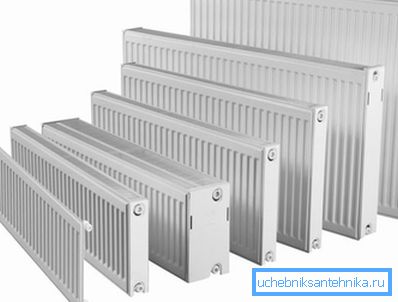
Features of these elements of the heating system:
- Structurally, the steel battery consists of two canvases of ordinary carbon steel, in which with the help of a press grooves are made for the passage of coolant. In order to prevent the formation of rust, the radiator material is treated with phosphate substances and degreased. The outer surface is covered with powder paint, inside the ribs are made of the same steel, increasing the area of contact with air.
- The battery design allows you to minimize:
- amount of heat carrier used;
- temperature to which water is heated;
- pressure required for the operation of the heating network.
However, the same factors completely exclude the use of steel heating panels in apartments connected to the centralized heat supply system.
Tip! The climate system with steel batteries must always be filled with water, otherwise the inner surface will quickly become rusty and the radiator will become unusable.
Calculation of radiator power
Choose a battery heating further. Once you have decided on the material and appearance, it is the turn of the calculation of the required power.
Previously, it was easy to determine the size. The number of sections was calculated by dividing in half the area of the heated room. Now a similar technique cannot be applied, since each radiator has a different power rating.
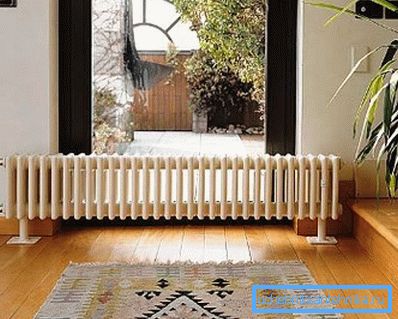
It is necessary to learn from the documentation (operating instructions) attached to the product. In addition, you will need the amount of energy used to heat 1 cubic meter of air in the room.
The figures for the most popular building materials in our country are:
- panel apartment building - 41 W;
- brick structure - 34 W;
- modern building, built using insulating materials - 20 watts.
To find out the power of the battery, you need to determine the volume of the room and multiply it by the above values. Then divide the resulting number by the power index of one section. As a result, you will find out their number for the battery installed in the room.
Conclusion
Now you know how to choose the right radiators for installation in a city apartment or a private house and make all the necessary calculations.
However, the performance of the climate system depends on many additional factors:
- used boiler;
- material;
- pipe diameter;
- the presence or absence of a pump;
- type of control electronics and so on.
In more detail about all this tells the video posted below.